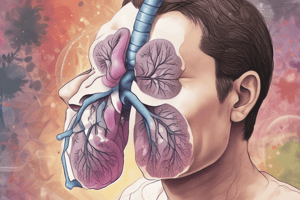Podcast
Questions and Answers
What is a symptom of bronchiectasis?
What is a symptom of bronchiectasis?
- Coughing up blood
- Shortness of breath
- Chronic cough with mucus production
- All of the above (correct)
What is a characteristic of salivary glands in a particular condition?
What is a characteristic of salivary glands in a particular condition?
- Low secretion of mucus and fibrosis
- Low secretion of NaCl and inflammation
- High secretion of mucus
- High secretion of NaCl and glandular fibrosis (correct)
What is the main cause of shortness of breath in emphysema?
What is the main cause of shortness of breath in emphysema?
- Under-inflation of the alveoli
- Constriction of the airways
- Inflammation of the bronchioles
- Over-inflation of the alveoli (correct)
What is a characteristic of chronic obstructive pulmonary disease (COPD)?
What is a characteristic of chronic obstructive pulmonary disease (COPD)?
What is the main effect of asthma on the airways?
What is the main effect of asthma on the airways?
What is a common cause of atelectasis?
What is a common cause of atelectasis?
What is the effect of atelectasis on ventilation and perfusion?
What is the effect of atelectasis on ventilation and perfusion?
What is the effect of sweat glands in a particular condition?
What is the effect of sweat glands in a particular condition?
What is the effect of mucus blockage in the reproductive system?
What is the effect of mucus blockage in the reproductive system?
What is the ultimate consequence of chronic obstructive pulmonary disease (COPD)?
What is the ultimate consequence of chronic obstructive pulmonary disease (COPD)?
Study Notes
General Manifestations of Respiratory Disease
- Breath sounds: rales (light, bubbly, or crackling sounds with serous secretions), rhonchi (deeper or harsher sounds from thicker mucus), and absence (non-aeration or collapse of lungs)
- Dyspnea: shortness of breath, feeling of discomfort, often caused by increased carbon dioxide or hypoxemia (low level of O2 in the blood), and often noted on exertion
- Paroxysmal nocturnal dyspnea: sudden acute type of dyspnea, common in patients with left-sided congestive heart failure, wakes up from sleep with cough and gasping for breath
- Orthopnea: occurs when lying down, usually caused by pulmonary congestion
- Cyanosis: bluish coloring of skin and mucous membranes, caused by large amounts of unoxygenated hemoglobin in blood
- Pleural pain: results from inflammation or infection of parietal pleura
- Friction rub: soft sound produced as rough, inflamed, or scarred pleural move against each other
- Clubbed digits: result from chronic hypoxia associated with respiratory or cardiovascular diseases, painless, firm, fibrotic enlargement at the end of the digit
- Changes in arterial blood gases: hypoxemia (inadequate oxygen in blood), hypercapnia (increased carbon dioxide in blood)
Infectious Diseases
- Lower Respiratory Tract Infections:
- Bronchiolitis: viral infection, caused by respiratory syncytial virus (RSV), transmitted by oral droplet, virus causes necrosis, inflammation in small bronchi and bronchioles
- Pneumonia: 3 types, including lobar pneumonia, bronchopneumonia, and interstitial pneumonia
Obstructive Lung Diseases
- Cystic fibrosis: inherited (genetic) disorder, gene located on chromosome 7, exocrine glands cause abnormally thick secretions, primary effects seen in lungs and pancreas
- Lungs: sticky mucus obstructs airflow, causing air trapping/atelectasis, permanent damage to bronchial walls, infections common, caused by Pseudomonas aeruginosa and Staphylococcus aureus, bronchiectasis and emphysematous causes respiratory failure and corpulmonale
- Digestive tract: abnormality in newborn is meconium ileus, preventing excretion of meconium, pancreas duct becomes blocked, leading to malabsorption and malnutrition, resulting in diabetes, bile duct becomes blocked, preventing bile from reaching duodenum, affecting digestion and absorption of fat and fat-soluble vitamins, severe obstruction causes inflammation and permanent damage to liver, causing biliary cirrhosis
- Bronchiectasis: permanent enlargement of parts of the airways of the lung, symptoms include chronic cough with mucus production, shortness of breath, coughing up blood, and chest pain
- Emphysema: long-term, progressive disease of the lungs, cause shortness of breath due to over-inflation of the alveoli
- Chronic obstructive pulmonary disease (COPD): chronic respiratory disorder, characterized by progressive tissue degeneration and airway obstruction, irreversible and progressive damage to lungs, debilitating conditions affect individuals' ability to work, may lead to co-pulmonary disease, respiratory failure may occur
- Asthma: inflammation of the mucosa with edema, bronchoconstriction (contraction of smooth muscle), increased secretion of thick mucus that blocks the airways, changes create obstructed airways, partial or total
Expansion Disorders
- Atelectasis: collapse of lung or part of the lung, leading to decreased gas exchange and hypoxia, alveoli become inflamed then collapse, process interferes with blood flow through the lung, ventilation and perfusion are altered
- Common causes of atelectasis: hypoventilation, compression, airway obstruction, and adhesion
Studying That Suits You
Use AI to generate personalized quizzes and flashcards to suit your learning preferences.
Related Documents
Description
This quiz covers the general manifestations of respiratory disease, including breath sounds, dyspnea, and paroxysmal nocturnal dyspnea. Understand the symptoms and signs of respiratory disorders.




